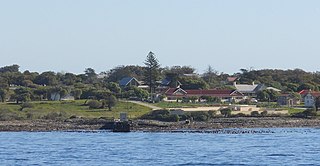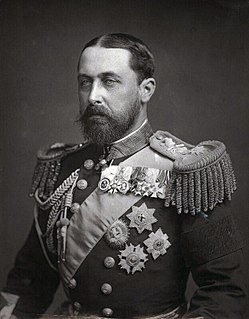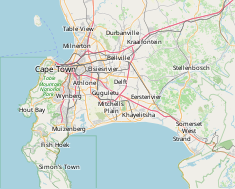
Robben Island is an island in Table Bay, 6.9 kilometres (4.3 mi) west of the coast of Bloubergstrand, north of Cape Town, South Africa. It takes its name from the Dutch word for seals (robben), hence the Dutch/Afrikaans name Robbeneiland, which translates to Seal(s) Island.

Bloemfontein, also known as Bloem, is the capital city of the Free State Province of South Africa; and, as the judicial capital of the nation, one of South Africa's three national capitals and is the seventh largest city in South Africa. Situated at an elevation of 1,395 m (4,577 ft) above sea level, the city is home to approximately 520,000 residents and forms part of the Mangaung Metropolitan Municipality which has a population of 747,431. It was one of the host cities for the 2010 FIFA World Cup.

Wilhelm Heinrich Immanuel Bleek was a German linguist. His work included A Comparative Grammar of South African Languages and his great project jointly executed with Lucy Lloyd: The Bleek and Lloyd Archive of ǀxam and !kun texts. A short form of this eventually reached press with Specimens of Bushman Folklore, which Laurens van der Post drew on heavily.

Alfred reigned as Duke of Saxe-Coburg and Gotha from 1893 to 1900. He was the second son and fourth child of Queen Victoria of the United Kingdom and Albert, Prince Consort. He was known as the Duke of Edinburgh from 1866 until he succeeded his paternal uncle Ernest II as the reigning Duke of Saxe-Coburg and Gotha in the German Empire.

The Victoria & Alfred (V&A) Waterfront in Cape Town is situated on the Atlantic shore, Table Bay Harbour, the City of Cape Town and Table Mountain. Adrian van der Vyver designed the complex.

The University of Cape Town (UCT) is a public research university located in Cape Town in the Western Cape province of South Africa. UCT was founded in 1829 as the South African College making it the oldest higher education institute in South Africa. In terms of full university status, it is the oldest university in South Africa and the oldest extant university in Sub-Saharan Africa together with Stellenbosch University which received full university status on the same day in 1918.

The Old Melbourne Gaol is a former jail and current museum on Russell Street, in Melbourne, Victoria, Australia. It consists of a bluestone building and courtyard, and is located next to the old City Police Watch House and City Courts buildings. It was first constructed starting in 1839, and during its operation as a prison between 1845 and 1924, it held and executed some of Australia's most notorious criminals, including bushranger Ned Kelly and serial killer Frederick Bailey Deeming. In total, 133 people were executed by hanging. Though it was used briefly during World War II, it formally ceased operating as a prison in 1924; with parts of the jail being incorporated into the RMIT University, and the rest becoming a museum.

The Port of Cape Town is the port of the city of Cape Town, South Africa. It is situated in Table Bay.

Boddam is a coastal village in Aberdeenshire, Scotland. It is 29 miles (47 km) north of Aberdeen and 3 miles (4.8 km) south of Peterhead. The settlement of Stirling Village lies immediately to the west. Sea cliffs rise to 200 feet (61 m), south of the village: a coastal path leads along these to the Bullers of Buchan.

Mouille Point ("Mu-lee") is an affluent suburb of Cape Town, situated between the Victoria and Alfred Waterfront and Granger Bay to the east, Green Point to the south and the Atlantic Ocean to the north and west. The suburb hugs the coastline and is dominated by high-end apartment blocks.

This article details the history of Newcastle, New South Wales from the first human activity in the region to the 20th century.

The Graduate School of Business (GSB) is the business school of the University of Cape Town (UCT), South Africa's oldest university.

SAS Somerset was a Bar-class boom defence vessel of the South African Navy, now preserved as a museum ship in Cape Town. Formerly HMS Barcross, it operated in Saldanha Bay, transferred to South Africa Naval Forces during World War II and was purchased by South Africa in 1947.

The Chavonnes Battery was a fortification protecting Cape Town, South Africa, built in the early 18th century. It is now a museum and function venue.

The Somerset Hospital in the Green Point area of Cape Town, South Africa opened in 1864 and has been declared a provincial heritage site.
The following is a timeline of the history of Cape Town in the Western Cape province of South Africa.

The Table Bay Harbour 0-4-0T of 1874 was a South African steam locomotive from the pre-Union era in the Cape of Good Hope.

The Table Bay Harbour 0-4-0WT of 1879 was a South African steam locomotive from the pre-Union era in the Cape of Good Hope.

The following outline is provided as an overview of and topical guide to Cape Town:
The Amsterdam Battery was the most important of the military installations built by the Dutch East India Company to protect Table Bay. It marked the beginning of coastal defense in South Africa.




















